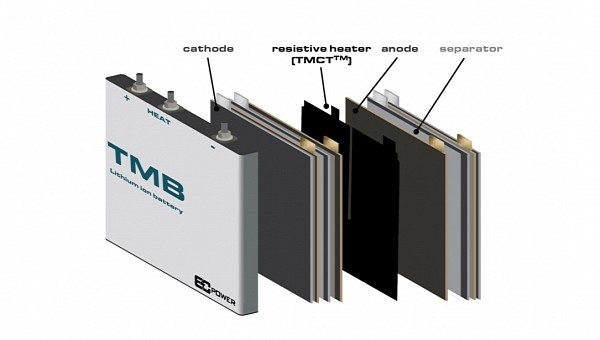We often write here about how important it is to develop battery technology. The current state of things gave us some electric vehicles, but they have intrinsic issues that will hinder wider adoption – starting with cost. A startup called EC Power may have found the solution without caring too much about the chemistry. Its Asymmetric Temperature Modulation (ATM) can deal with any of them and still obtain impressive results.
The company and Penn State University recently published a study on Nature that reports how they managed to charge an NMC811 cell with an energy density of 265 Wh/kg to 75% of charge in 12 minutes more than 900 times. The cell description could fit one of the 2170 batteries used by Tesla. According to the team involved with the study, “this is equivalent to a half-million-mile range in which every charge is a fast charge.” That is the most stressful charging method any battery can face.
What EC Power does is add “a 30-µm-thick nickel foil embedded in the center electrode layers. This very thin resistive heater is the main element of Thermally Modulated Cell Technology (TMCT), which also uses software to control the temperature increase inside the cell, how high voltage can be to fast charge it once the ideal temperature is achieved, and when to turn off the heater. The video below makes it seem way simpler than that and makes an interesting comparison with an internal combustion engine. The higher internal temperature avoids lithium plating and probably also helps prevent dendrites formation.
After fast charging, the cell temperature quickly drops below 40ºC “because of a large temperature difference driving fast heat dissipation.” According to EC Power, that temperature drop is so effective that a battery pack using this system would not require liquid cooling: “air convection” is more than enough. If that is correct, it saves a lot of weight and makes the battery pack way less complex.
The study states that “true fast charging batteries would have immediate impact.” One example it gives is that “a conventional long-range EV with a 120 kWh pack requiring an hour to recharge could be replaced with an EV with a 60 kWh pack capable of 10-min fast charging while maintaining very similar travel time during long-distance trips.” That could also save resources: electric cars would not need massive battery packs anymore. The smaller units would also be much cheaper, helping EVs achieve price parity with ICE competitors much faster.
Electric vehicles capable of fast charging that way would be equivalent to plug-in hybrids. What we mean is that they could have a battery pack only big enough for daily needs. They could eventually take road trips with these fast charging sessions EC Power wants them to accept. The issue is that such EVs would depend on a reliable fast-charging network, which is yet to be created in most places. In that sense, PHEVs still have an advantage.
With such a winning proposition, we wonder why we have not heard of EC Power before. It may have to do with taking the concept to production. The startup states that TMCT cells can be manufactured with the same equipment currently used to produce lithium-ion batteries. Now we just need to see automakers testing the idea and trying to sell it in production cars. We’ll try to learn more about that from the company.
What EC Power does is add “a 30-µm-thick nickel foil embedded in the center electrode layers. This very thin resistive heater is the main element of Thermally Modulated Cell Technology (TMCT), which also uses software to control the temperature increase inside the cell, how high voltage can be to fast charge it once the ideal temperature is achieved, and when to turn off the heater. The video below makes it seem way simpler than that and makes an interesting comparison with an internal combustion engine. The higher internal temperature avoids lithium plating and probably also helps prevent dendrites formation.
After fast charging, the cell temperature quickly drops below 40ºC “because of a large temperature difference driving fast heat dissipation.” According to EC Power, that temperature drop is so effective that a battery pack using this system would not require liquid cooling: “air convection” is more than enough. If that is correct, it saves a lot of weight and makes the battery pack way less complex.
The study states that “true fast charging batteries would have immediate impact.” One example it gives is that “a conventional long-range EV with a 120 kWh pack requiring an hour to recharge could be replaced with an EV with a 60 kWh pack capable of 10-min fast charging while maintaining very similar travel time during long-distance trips.” That could also save resources: electric cars would not need massive battery packs anymore. The smaller units would also be much cheaper, helping EVs achieve price parity with ICE competitors much faster.
Electric vehicles capable of fast charging that way would be equivalent to plug-in hybrids. What we mean is that they could have a battery pack only big enough for daily needs. They could eventually take road trips with these fast charging sessions EC Power wants them to accept. The issue is that such EVs would depend on a reliable fast-charging network, which is yet to be created in most places. In that sense, PHEVs still have an advantage.
With such a winning proposition, we wonder why we have not heard of EC Power before. It may have to do with taking the concept to production. The startup states that TMCT cells can be manufactured with the same equipment currently used to produce lithium-ion batteries. Now we just need to see automakers testing the idea and trying to sell it in production cars. We’ll try to learn more about that from the company.








